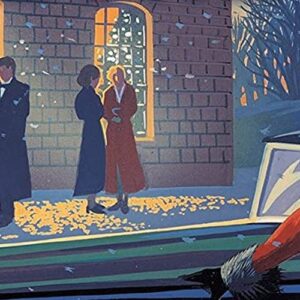Fiction is freedom in ink.
There’s nothing as freeing as pulling up to a blank page, where the only limitation to worlds, plot and character is our imagination. A blank page is a lot of things – expectation, potential, fear – but it is never one thing: restrictive. So it’s not surprising that some authors aren’t a fan of rules, and view them as creativity-crushing restrictions that better belong guiding a group (a classroom, a football team) in an activity than on our pages. I used to think like that too.
But here’s the thing: I write mystery novels. And writing mysteries is a team sport.
I’m not talking Holmes and Watson buddying up. It’s much more important than that. The author and the reader are the team. A mystery author should play alongside the reader, so we solve the crime together. Otherwise we are merely telling you everything, or, even worse, cheating you by playing unfairly. If you’ve ever felt the need to hurl a book at the wall because of a glaringly unfair twist, you know what it’s like when an author is working against you and not with you. And working together means knowing that we are playing the same game: we need to sing from the same hymn book, make plays from the same whiteboard, metaphor to the same metaphors. It requires – you guessed it – rules.
You may know thatAgatha Christie and her Golden Age contemporaries formed a group they called ‘the detection club’ – to meet and discuss mystery novels and their craft – complete with a membership oath swearing to play by the rules (that mysteries shall not be solved with ‘Mumbo Jumbo, Jiggery-Pokery, Coincidence, or Act of God’) with readers. Ronald Knox took it a step further and jotted out ‘The Ten Commandments of Detective Fiction’ in 1929. Reading through them now, it’s easy to appreciate two things: 1) They are mostly common-sense stuff; and 2) in the hundred years since they were written, mystery fiction has reinvented itself enough times to move beyond them. So they are both eternally valid and outdated at the same time.
With that in mind, I’d like to present a completely unscientific assessment of authors who pass or fail select rules according to 1929 standards. These aren’t reviews or criticisms, merely observations as they apply to the rules.
Also, warning: spoilers ahead.
Like, seriously. Heads up. Spoilers. Turn back now if you hate that kind of stuff.
Rule 1: The criminal must be someone mentioned in the early part of the story, but must not be anyone whose thoughts the reader has been allowed to follow.
Pass: The Adventures of Sherlock Holmes, Arthur Conan Doyle – Watson’s ever faithful chronicling of Holmes’ adventures leaves little doubt as to his innocence, as we see the case through the eyes of the unbiased observer. Also, more generally, the first part of this rule holds up the best in the modern age: most authors rigidly adhere to introducing all valid suspects by the midway point.
Fail: James Patterson, various – a prologue from the perspective of the villain is pretty much par for the course for a lot of crime fiction these days, and Patterson fails this rule with aplomb, using villain’s perspectives to up the tension of his cat and mouse game.
Rule 2: All supernatural or preternatural agencies are ruled out as a matter of course.
Pass: Mr Mercedes, Stephen King – It’s weird to put King with a ‘pass’ mark on the supernatural rule, however King’s foray into serious crime fiction was a down to earth procedural, as retired detective Bill Hodges uncovers a horrific attack, and King doesn’t need to stretch his considerable supernatural muscles, instead finding terror in real life evil.
Fail: End of Watch, Stephen King – I’m passing and failing King on this one, with this novel (the third and final novel in the Bill Hodges series) taking the next step and bringing supernatural horrors into his procedural world. While I’ve read books that have played it relatively straight before introducing some third act mayhem (Lauren Beuke’s excellent Broken Monsters and The Shining Girls among them), this is the only series I can think of that morphs genres over the course of the three books.
Rule 3: Not more than one secret room or passage is allowable.
Pass: Knives Out, dir. Rian Johnson – a ‘trick window’ revealing a secret door is used to great effect in this murder mystery film, which plays with conventions by adhering to and updating them at the same time.
Fail: The Devil and The Dark Water, Stuart Turton – a classic homage to Holmesian mysteries, set on high-seas voyage where a mysteriously ghostly murder takes place, the ship in question is replete with hidden passageways and gloomy alcoves as characters both good and bad scurry around the ship. I’m pretty sure Turton both breaks and adheres to almost every one of Knox’s rules in his brilliantly subversive novels.
Rule 7: The Detective must not himself commit the crime
Pass: Jack Reacher Series, Lee Child – if there’s one thing for certain, it’s that Lee Child’s hulking justice-dishing creation is never going to be the victim of a wild third act twist. It would go against his entire character and moral code.
Fail: Unspecified, Agatha Christie – What? I hear you gasp, you’re failing Agatha Christie? Yes, I am indeed. Christie was well known for pushing boundaries with her fiction. I’ve removed the specific title here as I’m not completely disrespectful to spoilers, but suffice to say that one particular novel of Christie’s completely upended the genre with her exceedingly clever twist. In fact, it’s rumored to have inspired Knox to write this very rule.
Rule 9: The stupid friend of the detective, the Watson, must not conceal any thoughts which pass through his mind; his intelligence must be slightly, but very slightly, below that of the average reader.
Pass: The Word Is Murder, Anthony Horowitz – in Horowitz’s brilliant meta-mysteries, of which this is the first, the conceit is that the author himself is writing a series of non-fiction books about a retired detective inspector he is tailing, Hawthorne. Horowitz has the good humor to give himself the Watson role, and sticks to this rule doggedly: getting a lot of mileage out of the fact that Horowitz is often barking up the completely wrong tree for suspects and theories, and allowing Hawthorne’s solves to be all the more dazzling.
Fail: Gone Girl, Gillian Flynn – While this wasn’t the birth of the unreliable narrator, it certainly was the coming of age, making such twists a staple of the genre that still persist. Flynn’s characters are multi-layered, complex, conniving, dishonest, and much much smarter than the reader. It’s a pleasure to be taken on the ride.
I hope this exercise has proven two counter-intuitive theories at the same time: that sometimes you can’t beat a classic, and that some rules are made to be broken. And if that intrigues you, a reminder that I write mystery novels, and if you want to be on my team: come play.
***


















